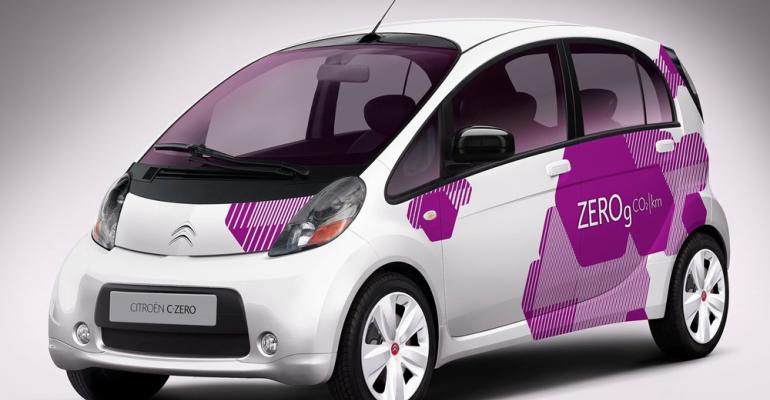PARIS – "France is a candidate to be the electric-vehicle leader," proclaims French Minister of Industrial Renewal Arnaud Montebourg at a welcome-home ceremony for a Citroen C-Zero driving team that made an 8-month, 15,535-mile (25,000-km) world tour on €332 ($300) worth of electricity.
“France can guide the electric revolution,” he tells well-wishers. “We want electric vehicles to be for everyone; all levels of society should have access to the electric car. The €7,000 ($9,100) support (support by the government) brings the Renault Zoe to the price level of the Clio or Peugeot 208.”
Montebourg’s pronouncement comes as French auto makers prepare to display electrified cars of all sizes at the biannual auto show here this week.
Renault will have its full lineup of Zoe, Twizy, Kangoo and Fluence EVs. Citroen plans to show its DS3 electric concept as well as the C-Zero that completed the lengthy journey. Peugeot will feature the iOn, sister to the C-Zero and Mitsubishi iMiEV.
In addition, a startup called Mia will show four small EVs, while Courb, another startup, will bring its C-Zen, the first car in France to be awarded the label “guaranteed to be of French origin.”
The Ministry of Industry Renewal has leaked information about the next level of support the government plans to give to EV buyers, which Montebourg is expected to announce at the Paris show. They include free parking, free passage on urban toll roads and financial aid for installing private recharging posts.
This is not the first time that France has launched itself into the EV future. In the 1990s, PSA Peugeot Citroen and Renault converted 10,000 small cars to electric power, but the experiment petered out, much like California's attempt at the same time. EV range from the lead-acid batteries of the time, high prices and lack of recharging infrastructure were blamed in both cases.
Now, with lithium-ion batteries adding range and federal tax credits of $7,500 in the U.S. and €7,000 ($9,100) in France reducing price, infrastructure has become the big hurdle.
Montebourg says his ministry will meet with local governments in Normandy and the north of France in the coming weeks to persuade them to push for electric-recharging posts in public rights-of-way, private parking garages, shopping centers and service stations.
The French government is working on changes to regulations regarding underground parking garages for apartment complexes, so that people can install private recharging posts.
But even with such government force behind the movement, infrastructure problems remain. Prime among them: Europe still has not decided what kind of plug to use for fast recharging.
"We will decide soon, in months," says Philippe Hirtzman, an engineer overseeing recharging safety at the economic ministry. A second problem – how much people should pay to use electric recharge stations that are available to the public – likely will have a number of solutions.
In some cases, the electricity might be free, but the parking space will have a fee, Hirtzman says.
Already in Paris, several recharging posts left over from the 1990s experiment still offer free electricity, as well as free parking during recharge. The 120 posts in Paris associated with the Autolib car-sharing program also are free for the Autolib cars made by Bollore, but other users must pay.
Another element that must be worked out is a system of recharging reservations, says Charlotte de Silguy, secretary general of the AVERE association that has been promoting EVs in France for more than 30 years.
She says the slow start of the EV industry is not a concerny, because the internal-combustion industry also started slowly a century ago, with little infrastructure in place and cars that were expensive.
The two drivers of the Citroen C-Zero saw a change in the EV landscape during their world tour.
"California has the most electric vehicles of anywhere," says Antonin Guy, 29, who was on a leave of absence from Cap Gemini Consulting to drive the tour. "And in Japan, there is a 20-minute recharge about every 50 km (31 miles) on the freeways."
The C-Zero recharged its battery more than 300 times on the trip, often at people's homes where recharging was done overnight. Guy says the car averaged 62-75 miles (100-120 km) per charge.
"If we can drive around the world in a production electric car," says co-driver Xavier Degon, who works for the French electric utility EDF, "everybody can use one for going to work or to do their shopping."





